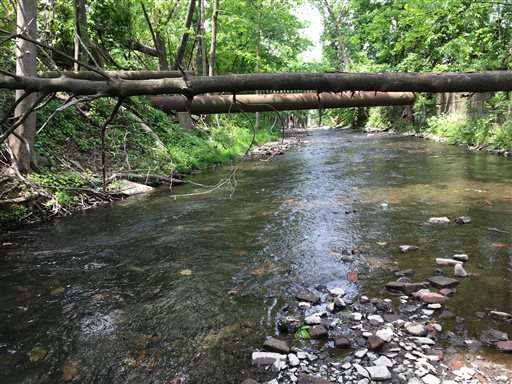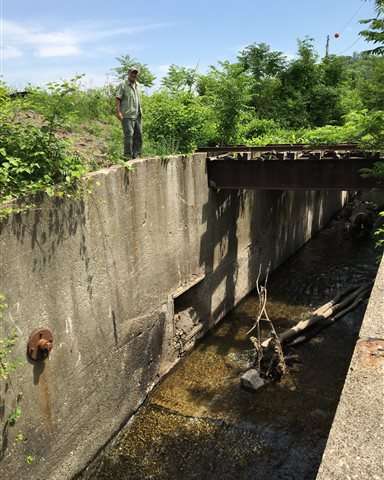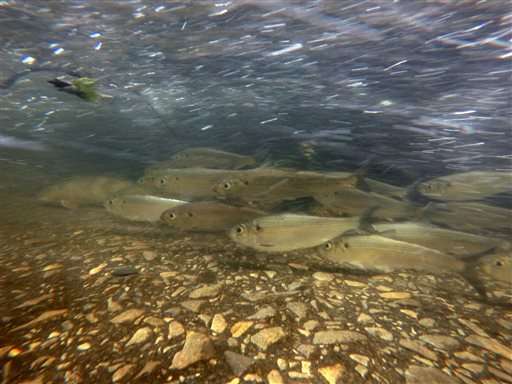Herring spawn in NY tributary for 1st time in 85 years

A few days after a long-abandoned industrial dam was removed from the mouth of a Hudson River tributary this spring, hundreds of river herring swarmed up into the shallow waters to spawn for the first time in 85 years.
The removal of the rusted steel dam on the Wynants Kill near Albany was the first of what ecologists hope will be many barriers removed in Hudson tributaries to restore spawning habitat for herring and other ocean-going species that have been devastated by habitat loss, pollution and overfishing.
The project is part of a larger movement that has dismantled almost 250 dams across the country since 2012, according to the conservation group American Rivers.
"There are more than 1,500 dams in the Hudson estuary watershed, most of them no longer in use," said Frances Dunwell, coordinator of the state Department of Environmental Conservation's Hudson River Estuary Program. "One of the key items on our to-do list by 2020 is to remove as many of these barriers as possible."
The estuary, which extends 150 miles north from the Atlantic Ocean, is an important breeding ground for several species of herring including American shad and alewife. In Colonial times, Hudson tributary streams flashed silver with herring during spring spawning runs. Dams built during the Industrial Revolution caused herring populations to crash along the Atlantic coast from South Carolina to Maine, and pollution and overfishing in more recent years made things worse.

Herring, especially American shad, are not only highly valued commercial and sport fish, but also are an integral part of the aquatic food chain. In the Atlantic, many species of fish, bird and mammal rely on herring as their primary food source. Striped bass recreational fishing, a major business in the Hudson estuary, uses river herring as baitfish.
In 2013, when the Atlantic States Marine Fisheries Commission required the 15 states it covers to submit plans for restoring historical spawning and nursery habitat, dams and climate change were cited as the largest threats.
"Every dam should have an existential crisis," said John Waldman, a biology professor at Queens College and long-time proponent of dam removal. "These are artifacts of the Industrial Revolution that are persisting and doing harm. We should decide which dams still serve a purpose and which should be removed."
A precedent for restoring a major river by dismantling a hydropower dam was set recently on Maine's Penobscot River, where the removal of two dams and construction of a fish bypass at a third opened 1,000 miles of habitat used by 11 species of sea-run fish. The dams' owner was able to increase total generation through enhancements at other dams in the watershed.

Most dam-removal projects are small dams that have far outlived their purposes. Last spring, shad swam up White Clay Creek in Delaware for the first time since a mill owner built a dam there in 1777. The timber-and-stone obstruction on the Delaware River tributary was removed in 2014 with $200,000 in federal and conservation group funding.
In the Hudson estuary, Dunwell said at least six privately owned unused dams have been targeted as good candidates for removal. The Department of Environmental Conservation will offer the owners grants and technical support for restoration projects.
The City of Troy removed the dam on the Wynants Kill tributary last month with a $12,500 grant from the state Environmental Protection Fund.
The dam, long hidden by the ruins of an old iron works, was discovered three years ago by John Lipscomb, who patrols the Hudson by boat for the Riverkeeper environmental group looking for polluters and testing water quality. On a recent tour of the former dam site, Lipscomb said decades of cleanup work have made the river much cleaner, but that's not enough.
"Success is not just a fishable or swimmable river," Lipscomb said beside the concrete-lined channel at the mouth of the Wynants Kill. "Now we want to restore the biological integrity to make it a living river again. That's the last step."
-

In this photo taken June 2, 2016, John Lipscomb, river patrol boat captain for Riverkeeper, looks over a concrete channel funneling the Wynants Kill into the Hudson River in Troy, N.Y. An old industrial iron dam was removed from the channel to allow ocean-going fish access to spawning and nursery habitat upstream in the tributary. (AP Photo/Mary Esch) -

In this photo taken May 19, 2016 and released by the New York State Department of Environmental Conservation, alewives swim up the Wynants Kill two weeks after an old industrial dam was removed to allow ocean-going fish access to the Hudson River tributary for spawning and habitat in Troy, N.Y. (Erica Capuana/New York State Department of Environmental Conservation via AP)
© 2016 The Associated Press. All rights reserved.




















